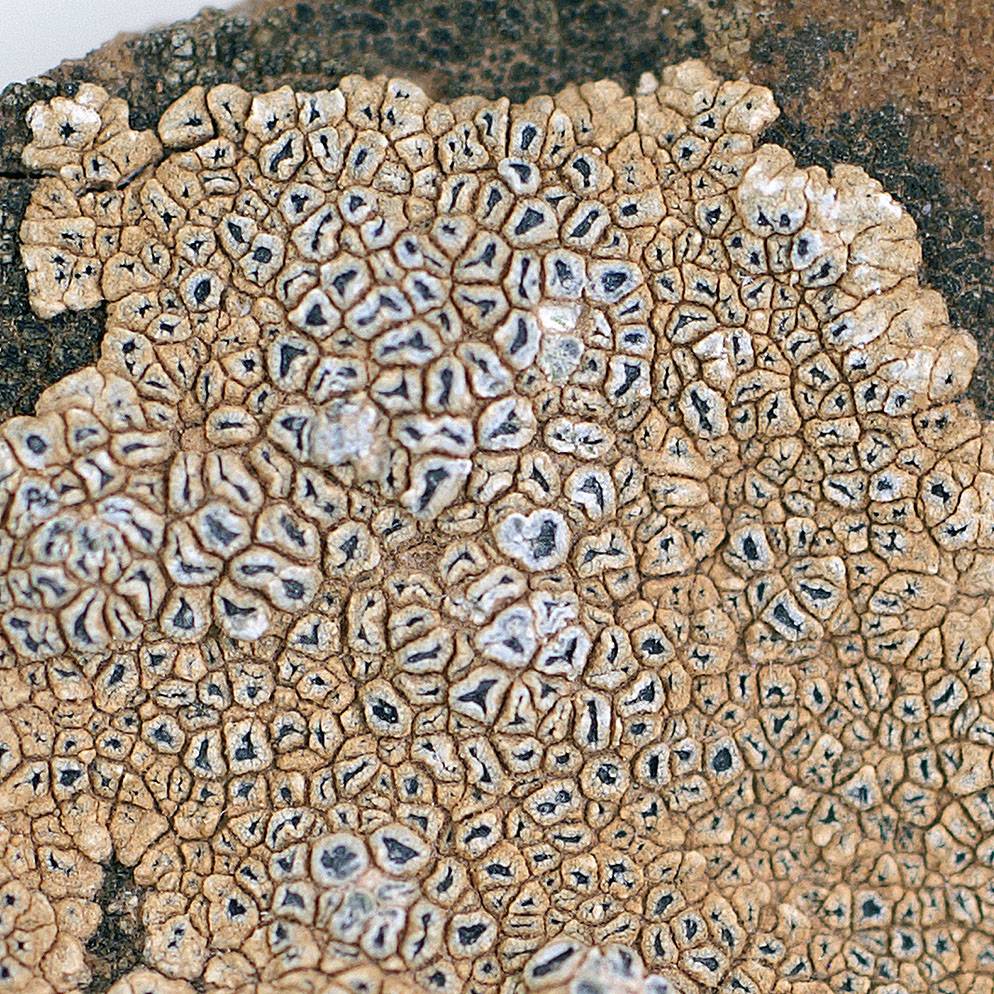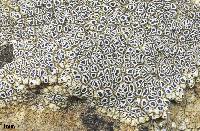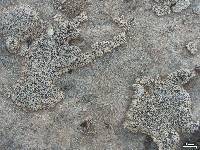
Consortium of Lichen Herbaria
- building a Global Consortium of Bryophytes and Lichens as keystones of cryptobiotic communities -
- Home
- Search
- Images
- Species Checklists
- US States: O-Z >
- US National Parks
- Central America
- South America
- US National Parks
- Southern Subpolar Region
|
|
|
|
Family: Megasporaceae
|
Nash, T.H., Ryan, B.D., Gries, C., Bungartz, F., (eds.) 2007. Lichen Flora of the Greater Sonoran Desert Region. Vol 3. Thallus: areolate, often orbicular, (0.3-)1-5 in diam., (0.2-)0.3-1(-1.2 mm) thick prothallus: not present or indistinct, at the thallus edge, brown to olive brown, up to 0.1 mm wide areoles: angular to sometimes irregular, flat, sometimes concave, rarely convex, in central part usually fertile, (0.3-)0.6-1.5(-1.8) mm in diam., contiguous, at the thallus edge subradiate with extended areoles, 1-2 x 0.5-1 mm, usually sterile surface: white to gray-white or yellow-white to white-red, orange-red or red (in bright contrast to the black discs of apothecia), dull and sometimes ±farinose due to crystals upper cortex: indistinctly delimited, (10-)20-35(-40) µm thick, with cells 5-7(-8) µm in diam.; cortex covered with Ca-oxalate crystal layer, 40-60-80(-110) µm thick, in uppermost part with red granules when surface red photobiont: chlorococcoid, cells ±round, 5-22 µm in diam Apothecia: aspicilioid, numerous in the middle of the thallus, (0.1-)0.2-0.6(-0.7) mm in diam., 1-2 (-5) per areole, round to angular, sometimes irregular disc: black, concave, more rarely flat, with ±white pruina thalline margin: thin, ±elevated or flat, sometimes crenulated, usually forming a white rim when thallus darker exciple: I- (lowermost part sometimes ±I+ blue), indistinct or (12-)20-60(-100) µm wide; uppermost cells ±globose or somewhat cylindrical, (4-)5-7(-8) µm in diam. epihymenium: brown to olive brown, with crystals, N+ green to sometimes blue green, K+ red-brown to brown hymenium: hyaline, I+ persistently blue or partly turning yellow, (50-)80-120(-160) µm tall paraphyses: moniliform, with (3-)4-6(-7) upper cells ±globose, 4-5(-6) µm wide, in lower part 2-3(-3.5) µm wide, not or slightly branched and anastomosing subhymenium and hypothecium: pale, I+ persistently blue, together (20-)30-60(-100) µm thick; algal layer continuous below the hypothecium asci: clavate, (35-)50-70 x 14-23 µm, 8-spored ascospores: hyaline, simple, ellipsoid to subglobose (-globose), (9-)10-15 x (6-)7-10 µm (2 globose spores 8 µm in diam. in the Sonoran material) Pycnidia: uncommon, 1-3/areole, immersed or somewhat elevated, with a black, punctiform ostiole, (50-)70-100 µm in diam. conidia: bacilliform, broad, (3-)4-6 x 1-1.5 µm Spot tests: cortex and medulla I-, K-, P-, C- Secondary metabolites: none detected by TLC. Substrate and ecology: on ±exposed limestone or calciferous sandstone, rarely on granite or gneiss World distribution: China (Gansu Province) altitude 1600-3000 m Sonoran distribution: found in Arizona (Yavapai, Maricopa, Coconino Counties), at 450-1740 m. Notes: Aspicilia determinata is characterized by its orbicular thallus that varies in color from white to red and that is subradiate at the edge, its brown epihymenium that becomes red-brown in K, its short hymenium, its continuous algal layer below the hypothecium, its small spores and its bacilliform conidia. It seems to be rather common in Grand Canyon National Park and is also found in Colorado. According to Magnusson (1940) the spores are globose (6-7 µm wide in water) or broadly ellipsoid (8-10 x 6.5-7.5 µm in K). In the type specimen (in S), however, the asci commonly contain also larger ellipsoid spores, measuring 9-15 x 6-9.5 µm in water, as occurs in the Sonoran material. Also the exciple width and the hymenium height show greater variation than mentioned in the original description. Although not mentioned by Magnusson, several pycnidia are present in the type, with conidia measuring (3.5-)4-5 x 1(-1.5) µm. There is also an algal layer below the hypothecium, as occurs in the Sonoran specimens. Thus, the type material and the Sonoran specimens agree very well in most characters, but the Sonoran material differs somewhat from the type by its thicker crystal layer, wider exciple and taller hymenium and in many specimens the thallus has a reddish tinge. The small spores, short conidia and the presence of algae below the hypothecium are characters also found in Aspicilia subgenus Pachyothallia Clauzade & C. Roux and the genus Lobothallia (Clauzade & C. Roux) Hafellner. These characters also distinguish A. determinata from another subradiate, orbiculate species in northern Arizona, A. boykinii. |
Powered by Symbiota



















